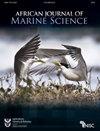Movement patterns and growth rate of the whitespotted wedgefish Rhynchobatus djiddensis in southern Africa based on tag-recapture data
IF 1.4
4区 生物学
Q3 MARINE & FRESHWATER BIOLOGY
引用次数: 4
Abstract
Information on the movement ecology of endangered species is critical for the implementation of effective conservation measures. This study made use of a long-term dart tagging dataset to reveal the movement patterns and growth rates of two size classes of the Critically Endangered whitespotted wedgefish Rhynchobatus djiddensis within its southern African distribution, which can have important implications for fisheries management. A total of 4 768 individuals were tagged with 340 recaptures recorded, ranging from 1 to 2 639 days (7.2 years) at liberty. Most of the tag releases and recaptures occurred within the KwaZulu-Natal central region in South Africa, with catches increasing significantly during summer (October to March). Most recaptures (43%) were recorded within 5 km of the tagging (release) site. Tagged adults recorded significantly greater distances moved than juveniles (p < 0.002) but there was no significant difference between juveniles or adults in terms of their direction of movement (p > 0.30). A Francis growth model showed that smaller individuals had a substantially faster growth rate (198.69 [SE 21.75] mm year−1) compared with larger individuals (57.41 [SE 27.83] mm year−1) confirming that the species is relatively slow-growing. Ultimately, this study identified important knowledge gaps in the broadscale movement patterns of R. djiddensis and provided new information on the growth rate of this Critically Endangered species. Filling in these knowledge gaps will aid in conservation measures for two important size classes of the R. djiddensis population as the species faces increasing targeted fishing pressure.基于标签重捕数据的非洲南部白斑楔鱼运动模式和生长率
关于濒危物种运动生态学的信息对于实施有效的保护措施至关重要。本研究利用长期飞镖标记数据,揭示了非洲南部分布的极度濒危白斑楔鱼(Rhynchobatus djiddensis)的两种大小类别的运动模式和增长率,这对渔业管理具有重要意义。共标记了4768只个体,记录了340次重新捕获,自由时间从1天到2639天(7.2年)不等。大多数释放标签和重新捕获发生在南非夸祖鲁-纳塔尔省中部地区,在夏季(10月至3月)捕获量显著增加。大多数捕获(43%)记录在标记(释放)地点5公里范围内。标记成虫的移动距离明显大于幼虫(p < 0.002),但幼虫和成虫在移动方向上无显著差异(p < 0.30)。Francis生长模型表明,小个体的生长速率(198.69 [SE 21.75] mm /年)明显快于大个体(57.41 [SE 27.83] mm /年),表明该物种生长相对缓慢。最终,本研究确定了吉毛鼠大规模迁移模式的重要知识空白,并为这一极危物种的生长速度提供了新的信息。填补这些知识空白将有助于采取保护措施,以保护两种重要大小类别的吉齿鼠种群,因为该物种面临越来越大的目标捕捞压力。
本文章由计算机程序翻译,如有差异,请以英文原文为准。
求助全文
约1分钟内获得全文
求助全文
来源期刊

African Journal of Marine Science
生物-海洋与淡水生物学
CiteScore
2.60
自引率
16.70%
发文量
17
审稿时长
6-12 weeks
期刊介绍:
The African (formerly South African) Journal of Marine Science provides an international forum for the publication of original scientific contributions or critical reviews, involving oceanic, shelf or estuarine waters, inclusive of oceanography, studies of organisms and their habitats, and aquaculture. Papers on the conservation and management of living resources, relevant social science and governance, or new techniques, are all welcomed, as are those that integrate different disciplines. Priority will be given to rigorous, question-driven research, rather than descriptive research. Contributions from African waters, including the Southern Ocean, are particularly encouraged, although not to the exclusion of those from elsewhere that have relevance to the African context. Submissions may take the form of a paper or a short communication. The journal aims to achieve a balanced representation of subject areas but also publishes proceedings of symposia in dedicated issues, as well as guest-edited suites on thematic topics in regular issues.
 求助内容:
求助内容: 应助结果提醒方式:
应助结果提醒方式:


